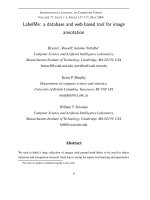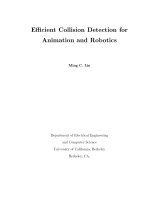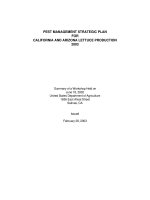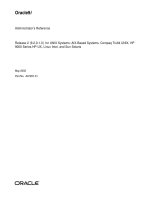Blender for animation and film based production
Bạn đang xem bản rút gọn của tài liệu. Xem và tải ngay bản đầy đủ của tài liệu tại đây (8.84 MB, 279 trang )
Blender
for Animation
AN A K PETERS BOOK
Michelangelo
Manrique
Blender for Animation and Film-Based Production explores why Blender is ideal for
animation films. It demonstrates Blender’s capability to do the job in each production
department. Whether you are a beginner or more advanced user, you’ll see why Blender
should be taken into consideration in animation and film production.
This Blender reference will help you:
• Manage your projects from start to finish
• Understand the different stages in any animation production
• See how studios work and develop their animation projects
Describing the versatility and power of Blender, the book shows you why studios should
incorporate Blender in their pipeline. It avoids tedious tutorials and incomprehensible
examples. Instead, the book guides you toward finding efficient solutions for issues
with your production files or pipeline. It familiarizes you with the animation industry and
explores the risks involved in choosing Blender as a primary tool in animation studios.
Features
• Includes examples of using the open-source software Blender in professional
productions
• Shows how versatile Blender’s features are in film/animation applications
• Provides useful information on setting up your home studio and producing a
successful project using Blender or other open-source software
• Presents basic principles of digital animation that can be used in any 3D application
Blender for Animation and Film-Based Production
and Film-Based
Production
Blender
for Animation
and Film-Based
Production
Michelangelo
Manrique
K21397
Computer Game Development
www.allitebooks.com
www.allitebooks.com
www.allitebooks.com
www.allitebooks.com
Boca Raton London New York
CRC Press is an imprint of the
Taylor & Francis Group, an informa business
AN A K PETERS BOOK
www.allitebooks.com
CRC Press
Taylor & Francis Group
6000 Broken Sound Parkway NW, Suite 300
Boca Raton, FL 33487-2742
© 2015 by Taylor & Francis Group, LLC
CRC Press is an imprint of Taylor & Francis Group, an Informa business
No claim to original U.S. Government works
Version Date: 20140624
International Standard Book Number-13: 978-1-4822-0475-9 (eBook - PDF)
This book contains information obtained from authentic and highly regarded sources. Reasonable efforts have been
made to publish reliable data and information, but the author and publisher cannot assume responsibility for the validity of all materials or the consequences of their use. The authors and publishers have attempted to trace the copyright
holders of all material reproduced in this publication and apologize to copyright holders if permission to publish in this
form has not been obtained. If any copyright material has not been acknowledged please write and let us know so we may
rectify in any future reprint.
Except as permitted under U.S. Copyright Law, no part of this book may be reprinted, reproduced, transmitted, or utilized in any form by any electronic, mechanical, or other means, now known or hereafter invented, including photocopying, microfilming, and recording, or in any information storage or retrieval system, without written permission from the
publishers.
For permission to photocopy or use material electronically from this work, please access www.copyright.com (http://
www.copyright.com/) or contact the Copyright Clearance Center, Inc. (CCC), 222 Rosewood Drive, Danvers, MA 01923,
978-750-8400. CCC is a not-for-profit organization that provides licenses and registration for a variety of users. For
organizations that have been granted a photocopy license by the CCC, a separate system of payment has been arranged.
Trademark Notice: Product or corporate names may be trademarks or registered trademarks, and are used only for
identification and explanation without intent to infringe.
Visit the Taylor & Francis Web site at
and the CRC Press Web site at
www.allitebooks.com
To my lovely wife and children.
www.allitebooks.com
www.allitebooks.com
Contents
Preface, xiii
Author, xv
CHAPTER 1 ▪ Why Blender?
1
CHAPTER 2 ▪ History of Blender
9
2.1 BLENDER’S ROAD MAP
CHAPTER 3 ▪ Blender User Interface
10
15
3.1 START-UP BLENDER
16
3.2 CONTROLS AND BUTTONS
19
3.3 EDITOR SYSTEM
21
..
..
..
Editor’s Header
Systematize Editors
Workspace Layout
... Configuring our Workspace Layout
.. Scenes
... Configuring Our Scene
3.4 EDITOR TYPES
..
..
..
..
..
..
..
..
..
26
D View
Timeline
Graphic Editor
DopeSheet
NLA Editor
UV/Image Editor
Video Sequence Editor
Text Editor
Node Editor
vii
www.allitebooks.com
viii
Contents
..
..
..
..
..
..
..
Logic Editor
Properties Editor
Outliner
User Preferences
Info Window
File Browser
Console
3.5 MODES AND CONTEXT
45
3.6 INTERNATIONALIZATION
48
CHAPTER 4 ▪ Blender in a Digital Studio Pipeline
4.1 USING BLENDER FOR PREPRODUCTION TASKS
..
..
..
Developing the Script with Blender
Using the Video Sequence Editor to Build the Storyboard
Creating Concept Art
49
51
4.2 USING BLENDER FOR POSTPRODUCTION TASKS
54
4.3 ORGANIZE THE PROJECT IN DISK
56
4.4 BLENDER AND THE OPEN MOVIES
57
CHAPTER 5 ▪ Modeling Your Main Character
61
5.1 MODELING IN BLENDER
64
5.2 MODIFIERS
65
5.3 MAKING PROPS
68
5.4 BUILDING THE ENVIRONMENT OF THE SCENE
75
5.5 TOPOLOGY SOLUTIONS
76
CHAPTER 6 ▪ Applying Materials to Our Objects
81
6.1 PREVIEW
85
6.2 DIFFUSE
85
6.3 SPECULAR
86
6.4 SHADING
87
6.5 TRANSPARENCY
88
6.6 MIRROR
90
6.7 SUBSURFACE SCATTERING
91
6.8 STRAND
92
6.9 OPTIONS
93
6.10 SHADOW
93
www.allitebooks.com
Contents
CHAPTER 7 ▪ Blender Internal Textures
ix
97
7.1 PREVIEW
101
7.2 COLORS
101
7.3 MAPPING
101
7.4 INFLUENCE
103
CHAPTER 8 ▪ UV Unwrap and External Textures
105
8.1 UNWRAPPING A MESH
105
8.2 UV LAYOUTS
106
8.3 EDITING UVS
107
8.4 OPTIMIZE THE UV MAP
110
8.5 COMBINE UV MAPS
111
8.6 REFINE LAYOUT
112
8.7 APPLYING IMAGES
113
CHAPTER 9 ▪ Introduction to Rigging: Armatures and Bones
117
9.1 THE ARMATURE OBJECT
119
9.2 BONES
121
..
..
Bones’ Segments
Bones’ Influence
CHAPTER 10 ▪ The Animation Process
131
10.1 TIMELINE AND ANIMATICS
132
10.2 MARKERS
133
10.3 KEYFRAMES
134
10.4 TYPES OF ANIMATION
136
.. The Twelve Principles Developed at Disney
10.5 USING CONSTRAINTS IN ANIMATION
136
10.6 SHAPE KEYS
137
10.7 WALKCYCLE
139
CHAPTER 11 ▪ Introduction to Lighting
141
11.1 LAMPS
142
11.2 SHADOW
142
11.3 ENVIRONMENT LIGHT
143
11.4 AMBIENT OCCLUSION
143
11.5 RESOLVING ISSUES WITH LIGHTS
144
x
Contents
CHAPTER 12 ▪ Compositing Nodes
149
12.1 SETTING UP NODES
150
12.2 USING NODES
151
12.3 NODE TYPES
154
..
..
..
..
..
..
..
..
Input Nodes
Output Nodes
Color Nodes
Vector Nodes
Filter Nodes
Convertor Nodes
Matte Nodes
Distortion Nodes
CHAPTER 13 ▪ Using Particles and Dynamics
13.1 DYNAMICS AND FORCE FIELDS
..
..
..
..
..
..
..
..
..
..
..
..
Drag
Turbulence
Boid
Curve Guide
Texture
Lennard-Jones
Charge
Harmonic
Magnetic
Vortex
Wind
Force
167
169
13.2 COLLISIONS
175
13.3 PARTICLES
177
..
..
..
..
..
..
..
..
Emission
Velocity
Rotation
Physics
Render
Display
Children
Field Weights
Contents
.. Force Field Settings
.. Cache
13.4 SOFT BODY
.. Soft Body Solver
.. Soft Body
xi
184
13.5 CLOTH
186
13.6 FLUIDS
188
13.7 SMOKE
195
.. Flow
CHAPTER 14 ▪ Render
14.1 BLENDER INTERNAL
..
..
..
..
..
..
..
..
..
..
..
Render
Dimensions
Antialiasing
Sampled Motion Blur
Shading
Performance
Post Processing
Freestyle
Stamp
Output
Bake
199
200
14.2 CYCLES
205
14.3 EXTERNAL RENDER ENGINES
206
.. Freestyle
.. Yafray
14.4 RENDER SETTINGS AND TIPS
.. Using Layers to Organize Our Render
.. When Something Goes Wrong
CHAPTER 15 ▪ Final Movie Compositing
15.1 USING BLENDER IN POSTPRODUCTION
.. Effects
208
213
213
... Add
... Subtract
... Alpha Over and Alpha Under
xii
Contents
... Cross
... Gamma Cross
... Multiply
... Wipe
... Glow
... Transform
... Color
... Speed Control
... Multicam Selector
... Adjustment Layer
.. Audio
CHAPTER 16 ▪ Python
219
16.1 PYTHON API
220
..
..
..
..
..
..
..
Accessing Data
Accessing Attributes
Creating or Removing Data
Context
Operators
Example
Types
... Native Types
... Internal Types
... Mathutils Types
.. Animation Using Python
16.2 BLENDER/PYTHON API IN FILM PRODUCTION
CHAPTER 17 ▪ Film Promotion and Conclusion
17.1 CONCLUSION
APPENDIX, 241
REFERENCES, 243
INDEX, 245
227
239
240
Preface
T
he idea for this book started quite some time ago—when I was working on the project
that became my Blender Foundation Certified Trainer certificate. At that time, , I
wanted to write about how I created that animation project from scratch. I thought that
sharing this experience may be useful to others with similar interests.
That project ended in my homemade studio, where I developed my personal projects.
It was also the place where I carried out my professional and educational activities.
This book remained in a corner in that small studio waiting to be completed some day.
In the meantime, Blender was upgraded several times, with new code and completely new
features. For this reason, this book has been reviewed and updated several times to keep up
with Blender’s latest releases.
My intention is not to write a detailed manual about Blender’s features, or where to find
specific buttons. Nor is this a book laid out in the form of a structured tutorial. I would like
to think of this book as a mixed bag, where I share my experiences with Blender, and discuss
its usefulness in most of today’s studios.
The purpose of this book is to show why Blender is perfect for animation films, demonstrating Blender’s capability to do the job in each production department.
Some parts of this book may be oriented toward beginners, some to advanced learners,
and some to professional users. I will not explain what every button does but what options are
available. I like to let people explore, discover, and learn on their own. A positive approach
toward Blender is always a good starting point in learning how it could be used for film
production.
The reasons I chose to work with Blender will be detailed in Chapter , Why Blender,
but how this application became my favorite is something you will discover in the rest of
the pages. I will be very glad if you can understand and benefit from the possibilities of this
wonderful suite.
My goal is to familiarize you with the animation industry, and to achieve this goal, demonstrating that Blender is as good as any other suite is my objective. The risks involved in
choosing applications like Blender as a primary tool in animation studios is something we
will see along the course of this book. Knowing this is important in understanding the way
the film industry works.
Let us go ahead and see how film production works and why Blender should be taken into
consideration.
xiii
Author
B
orn on May , , Michelangelo Manrique has always been interested in the fine arts,
which not only encouraged him to pursue university education in history of art, but also
to work as a painter and an art curator. Michelangelo is also technologically adept, which led
him to Blender in . Blender caught his attention right away and he was fascinated by
this D suite’s workflow and many possibilities.
Currently, Michelangelo is a programmer and D artist. He is working toward developing animation productions and rigging. He is also involved in publishing tutorials and
writing books, while he also conducts different courses on Blender. He is available for freelance or collaborative work with other studios. Michelangelo offers different Blender courses
designed to suit individual student needs. For teaching, he uses video-conferencing software to interact with students and share each other’s desktops. The topics covered in his
courses are: Blender interface and basics, modeling, shading and textures, rigging, animation, lighting, rendering, compositing and nodes, dynamics, and Blender production
pipeline.
xv
CHAPTER
1
Why Blender?
I
consider Blender to be the best D content creation suite I have ever used due to several
reasons. It’s not at the top of my list for sentimental reasons or because it’s the only one I
have used; it’s at the top of my list simply because I feel really comfortable working with it.
You have probably come across a lot of open source and free software. Blender is one of the
most popular applications not only in the open source community but also in the D content
environment, and it has been climbing the list of D creation suites in recent years.
If you are interested in open source or free software, check the websites of the Free Software
Foundation at and the Open Source Initiative at .
Blender has seen a lot of success throughout its history—not just in developing opensource movies but also in building a growing community around it.
But Blender has also had some hardships: refactoring stress, license issues, or the fear of
studios introducing Blender in their pipeline.
It is worth comparing Blender supported by a small group of developers, mostly volunteers, with other D creation suites supported by a large number of official developers, a big
infrastructure, and a lot of money invested in research and development. I want to emphasize that this doesn’t mean a better product, but sufficient resources if organized well might
end in a better product.
This is also comparable to the perspective on big and small studios. Big studios’ films
are not necessarily always the better ones or worthy of awards just because they have the
infrastructure and funds for research and development (Figures . and .). Small studios
also have a lot of great ideas, but lack infrastructure or funds to put their ideas to work.
Blender’s workflow and the strong community supporting Blender are probably the
two best reasons to use Blender as your main D creation suite for small productions or
homemade studios.
Is it only suitable for small projects and homemade studios? No, Blender is also suitable
for enterprises, big studios, and universities and colleges because it is not only used for D
films or by artists but also by professionals in varied disciplines like mathematics and science.
A search on the Internet would reveal the various kinds of professional institutions that are
successfully using Blender on a day-to-day basis, as shown in Figure ..
2
Blender for Animation and Film-Based Production
FIGURE 1.1 (See color insert.) The Wind is Changing by Andy Goralczyk, . Awesome render-
ing demonstrating how powerful Blender can be in the right hands. This still is an awesome render
from years ago. I can assure you that Blender has improved even more in its latest releases, so can
you reach the limits?
A good example is the University of Castilla-La Mancha, which has been using Blender in
many of its projects thanks to Dr. Carlos González Morcillo, Blender Foundation–certified
trainer and associate professor of the Department of Technology and Information System at
the University of Castilla-La Mancha.
One of the scientific projects developed in Blender is Ganas, a nonlinear animation of
characters for sign language representation.
Blender conferences have showcased many projects in the field of science, education, and
the like. A lot of interesting, non–D film related projects are being developed by professionals or amateur artists in a very wide range of activities. Projects like BioBlender, and others
developed by the TOSMI (Training in Open-Source Multimedia Instruments) group and
for archaeological research do not use the D feature of Blender but have turned out to be of
quite good quality.
“Blender is for artists” might have been the software’s initial goal, but, in fact, Blender has
been used in so many different areas that they are the ones that contribute much toward its
improvement. A lot of new features are suggested and bugs are reported and fixed.
www.allitebooks.com
Why Blender?
3
FIGURE 1.2 (See color insert.) Gorilla by Everett Gunther. Interesting use of Blender’s particle
system.
FIGURE 1.3 (See color insert.) Contractile Ring simulation by BioBlender. Here, we see how Blender
is used in scientific projects.
4
Blender for Animation and Film-Based Production
The results you get with Blender are obviously based on your skills, like in any other application you use or activity you perform. The best thing about Blender is that an amateur can
create projects with ease without prior knowledge of the software.
I know that it is hard to believe given Blender’s complicated interface and I totally agree
that it will look a bit scary for amateurs at the beginning but I’ll tell you why this perception
is wrong.
Sometime back I read something really interesting in Iker J. de los Mozos’ blog,
. Iker is a great artist and rigger and has worked in very interesting projects, including movies like Planet , The Missing Lynx, The Lady and the Reaper,
Justin and the Knights of Valour, and Frozen.
I came across some words in his blog that set me thinking about the way we have to
approach new software. He basically said that we cannot learn to handle new software
correctly if we approach it with preconceived notions.
In other words, we cannot learn and grasp everything that Blender can offer us if we
approach Blender software with our knowledge of the Maya software. It’s very interesting
to start from scratch like a newbie, letting the software surprise us. This will result in a better learning curve than trying to do in Blender what you can do in Maya or any other D
creation suite.
The Blender interface has been a highly debated topic in computer-generated imagery
forums and communities. A whole range of new proposals, changes, and implements are
available on the internet but we will be quite mistaken if we approach Blender with any other
D suite in mind.
We must discard our conventional ideas and approach Blender as total newbies. Ultimately, Blender is not harder to learn than any other application is for people starting
from scratch. The problem lies in the fact that people try to find the same things in the same
place even when the applications are very different.
As mentioned earlier, the Blender interface has been a very hot topic in various communities and forums. Recently, a study by Andrew Price, , revealed in
the Blender Conference and titled The Big Issues demonstrated popular interest in the
Blender user interface.
That study showed that although many people are comfortable with the new interface, a
significant number of people totally disagree with it, and are the reason for Blender not being
popular.
A couple of clicks, surfing between windows, areas and panels are all you need to navigate
through Blender. You can argue that it is this aspect of Blender’s user interface that makes
you avoid it. I cannot blame you for thinking so because it can be confusing when you use it
for the first time, but, believe me, it is not really so hard to understand.
When you get used to Blender’s user interface—and you do not need much time for
that—the workflow is one of the best as it allows you to develop your project in a comfortable way.
Once you learn to use the basic operators and their keyboard shortcuts, you will enjoy
developing new objects, characters, and scenes; applying materials and textures to your
models or providing an armature, and animating your characters.
Why Blender?
5
FIGURE 1.4 (See color insert.) Big Buck Bunny project developed by the Blender Institute. The open
movies developed by the BI represent a great example of Blender used for film production.
Over the years, I found people giving very different reasons for not using Blender,
like it’s frustrating using Blender if you don’t know the keyboard shortcuts. I will concede that the earlier versions of Blender were difficult but in the recent versions of
Blender, the user interface has been simplified to such an extent that this statement is
baseless.
It is true that some conventions like the use of left and right mouse buttons can be
improved but those shortcomings are like small drops in the ocean.
Blender is powerful and can be effective in animation studios as the main studio creation
suite or, in the worst case, as a shared application helping in some specific areas. I will be
honest and agree that adopting Blender in a big studio’s pipeline could be taking too much of
a risk for several reasons but I am confident it will work as well as any other private software
as a shared tool (Figures . and .).
Using Blender as the main tool in very big studios is not only an utopian because, we
should be honest, there are a lot of economical interests in adopting one or another creation
suite. Ultimately, everything is determined by the market and some applications, as mentioned earlier, expend a lot of human and economical resources to improve their position in
the market (Figure .).
The number and reliability of Blender’s features and the variety available makes Blender
the perfect application to use. Modular implementations and new features that people propose every day are introduced into Blender’s trunk code a feature that others cannot claim
they have.
Blender is an open-source software and has one of the biggest and most enthusiastic
communities helping in source code development and sharing years of knowledge and
experience. A growing number of educational institutions are also supporting it as partners.
6
Blender for Animation and Film-Based Production
FIGURE 1.5 (See color insert.) Tears of Steel is another great example not only for Blender used in
animation films but also for vfx projects.
FIGURE 1.6 (See color insert.) Sintel became a very ambitious project for the Blender Foundation
and served as an important test for new awesome features added to Blender’s code.
Like other applications, Blender is always evolving, and improving its interface even while
it is trying to become a really interesting and strong creation suite for artists. In the final
analysis, as mentioned earlier, Blender is not only for artists but also for other disciplines
such as education, architecture, and science.
The fine quality of the work produced by several artists using Blender is in itself proof
that Blender suits artists’ needs. Although we cannot claim that Blender is the best ever D
Why Blender?
7
application in the world, which no other software can also claim to be, we can argue that
Blender is one of the most interesting D applications in the world with the additional point
advantage of being completely free and open to you.
This book focuses on new Blender users but, from my point of view, it could also be interesting for those who are more knowledgeable in the subject, because they could use this book
to recollect old stuff learned in the past or to update their current knowledge of recently
added features.
I still use Blender’s wiki documentation for information on something I am working on,
which is not a bad practice at all. It will be futile to try to understand all the features in
Blender at one go—in fact nobody should attempt to do so—for manuals and information
sources like books are the only way to get all answers to our questions even when we are not
connected to the Internet.
This book introduces you to many of these questions. I am sure there are different ways
to solve any issue or to complete any Blender exercise successfully, however the solutions
I propose in this book are those I have actually used in my homemade studio.
They are not necessarily the best solutions, but they will help you to get reasonably good
results in your project. Remember that the purpose of this book is to create a Blender reference to help people manage projects from start to finish, to understand the different stages
in any animation production, and to throw some light on how studios work and develop a
complete animation project (Figures . and .).
It will be difficult to provide all these in a single book—there could be something that
I might miss—but I will make an honest effort to put down everything that is needed.
FIGURE 1.7 (See color insert.) Tube, an open movie developed by Bassam Kurdali and urchn.org.









